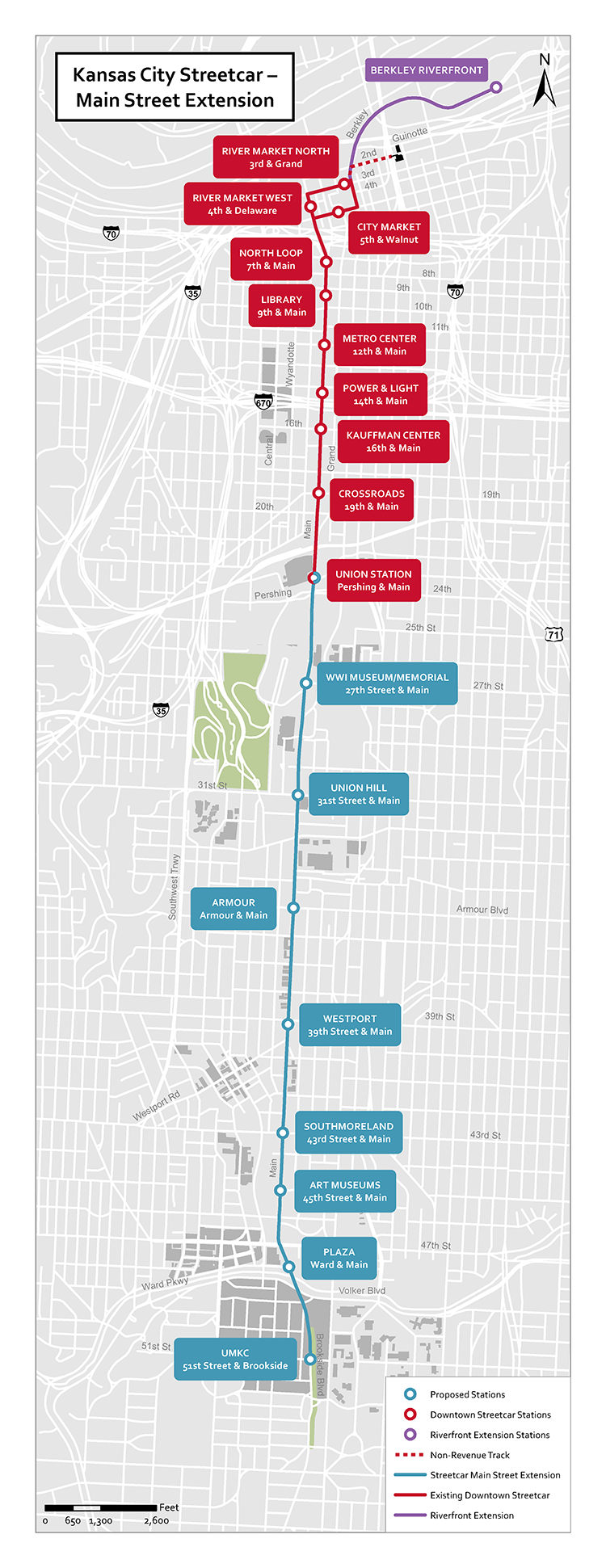Kansas City Streetcar Main Street Extension

Kansas City Streetcar Main Street Extension
Quickly Navigating Federal Grants to Expand a Successful Streetcar Line
The success of the initial downtown Kansas City Streetcar brought community support and enthusiasm for an extension, but the project’s expanded scope and capital costs required participation in the Federal Transit Administration’s New Starts Capital Investment Grant program to make the vision a reality.
Our team, which also helped with the first streetcar project, came in to help accelerate the FTA grant work as well as project planning and design to meet aggressive timelines.
The Main Street Extension project will add 3.5 miles of new streetcar alignment with eight new stop locations, connecting downtown Kansas City with the Country Club Plaza district and the University of Missouri-Kansas City. The Main Street Extension will help to further connect Kansas City, serving as a new spine for the city’s transit network and furthering economic development opportunities in the Crossroads, Midtown and South Plaza neighbourhoods. The 2.2-mile Downtown Line has been one of the most successful modern streetcar projects in the U.S., spurring billions of dollars in new downtown investment and generating more than 10 million trips within the first six years of service.
On Jan. 8, 2021, the Main Street Extension project executed a Full Funding Grant Agreement with the FTA for $174 million as part of the FTA New Starts CIG, representing 49.5% of the anticipated capital cost.
Accelerated FTA Process
Though well supported locally, the project had limited local funds for project development, so it needed to pursue federal funding as quickly as possible within a limited budget. HDR was able to work with the City of Kansas City, Missouri, project partners, and FTA to identify a path forward to satisfy the New Starts grant requirements within the available budget.
During the engineering phase of the program, the project was provided a unique opportunity as one of six FTA projects selected for an “accelerated” FFGA review. This opportunity required the HDR team to compress approximately three months of design, planning and cost estimating activities into three weeks to meet the accelerated FTA schedule. The team was able to meet the deadline, while still satisfying all FTA New Starts requirements — executing the FFGA approximately nine months ahead of schedule.
The project was one of the first FTA New Starts projects to be approved through “virtual” risk reviews. These reviews would normally be conducted on-site, with FTA staff reviewing the project corridor and engineering challenges in person. The HDR team collected drone footage and supplemented with design renderings to help facilitate this virtual review.
Designing a New Transit Spine for Commuters
The Main Street Extension nearly doubles the existing streetcar line. And further, while the existing line is mainly serving downtown riders and visitors to the area, the Main Street Extension with its longer reach is planned to be a commuter transit spine.
This meant new design considerations, including exclusive and semi-exclusive guideway, particularly toward the southernmost part of the new line. The two final stops, at the Country Club Plaza and the UMKC, include large, off-street structures with a canopy, similar to what one might expect at a light rail stop. In the areas where the streetcar runs on the street with autos, the design includes a more aggressive transit signal priority system.
In all, this line will become a key part of the Kansas City metro area’s transit network
Utility Coordination
HDR has been managing the utility coordination effort for this project since spring of 2019. Preceding the streetcar construction activities (which started in Spring 2022), utility relocations are being completed within the public right of way, including replacement of an existing water main, relocation and upgrades to existing storm and sanitary sewer, and relocations of approximately 20 private utilities. This effort is being coordinated by HDR through an online portal which includes GIS-based mapping, combined work schedules, maintenance-of-traffic plans and as-built conditions. This online portal has helped to minimize conflicts and keep these approximately 20 individual utilities on schedule to complete their activities in advance of streetcar construction — greatly mitigating a significant risk to project schedule.



